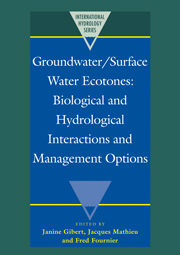Book contents
- Frontmatter
- Contents
- List of authors
- Preface
- I INTRODUCTION
- II FUNCTION OF GROUNDWATER / SURFACE WATER INTERFACES
- 2 Ecotonal animal assemblages; their interest for groundwater studies
- 3 Stochasticity in resource utilization by a larval chironomidae (diptera) community in the bed sediments of a gravel stream
- 4 Temporal and spatial dynamics of meiofaunal assemblages in the hyporheic interstitial of a gravel stream
- 5 Interstitial fauna along an epigean-hypogean gradient in a Rocky Mountain river
- 6 Filter effect of karstic spring ecotones on the population structure of the hypogean amphipod Niphargus virei
- 7 Community respiration in the hyporheic zone of a riffle-pool sequence
- 8 Diversity, connectivity and variability of littoral, surface water ecotones in three side arms of the Szigetköz region (Danube, Hungary)
- 9 Seasonal dynamics and storage of particulate organic matter within bed sediment of three streams with contrasted riparian vegetation and morphology
- 10 Bedsediments: Protein and POM content (RITRODAT-Lunz study area, Austria)
- 11 Dynamics and vertical distribution of particulate organic matter in river bed sediments (Morava River, Czech Republic)
- 12 Surface water/groundwater/forest alluvial ecosystems: functioning of interfaces. The case of the Rhine floodplain in Alsace (France)
- 13 Modelling of hydrological processes in a floodplain wetland
- 14 Contribution to the groundwater hydrology of the Amboseli ecosystem, Kenya
- 15 The role of hydrology in defining a groundwater ecosystem
- 16 Typology of water transport and chemical reactions in groundwater/lake ecotones
- 17 Development of a water transfer equation for a groundwater/surface water interface and use of it to forecast floods in the Yanghe Reservoir Basin
- 18 Uses and limitations of ground penetrating RADAR in two riparian systems
- III MALFUNCTION OF GROUNDWATER / SURFACE WATER INTERFACES: CAUSES AND METHODS OF EVALUATION
- IV MANAGEMENT AND RESTORATION OF GROUNDWATER / SURFACE WATER INTERFACES
- V CONCLUSION
- ANNEX
9 - Seasonal dynamics and storage of particulate organic matter within bed sediment of three streams with contrasted riparian vegetation and morphology
Published online by Cambridge University Press: 07 September 2010
- Frontmatter
- Contents
- List of authors
- Preface
- I INTRODUCTION
- II FUNCTION OF GROUNDWATER / SURFACE WATER INTERFACES
- 2 Ecotonal animal assemblages; their interest for groundwater studies
- 3 Stochasticity in resource utilization by a larval chironomidae (diptera) community in the bed sediments of a gravel stream
- 4 Temporal and spatial dynamics of meiofaunal assemblages in the hyporheic interstitial of a gravel stream
- 5 Interstitial fauna along an epigean-hypogean gradient in a Rocky Mountain river
- 6 Filter effect of karstic spring ecotones on the population structure of the hypogean amphipod Niphargus virei
- 7 Community respiration in the hyporheic zone of a riffle-pool sequence
- 8 Diversity, connectivity and variability of littoral, surface water ecotones in three side arms of the Szigetköz region (Danube, Hungary)
- 9 Seasonal dynamics and storage of particulate organic matter within bed sediment of three streams with contrasted riparian vegetation and morphology
- 10 Bedsediments: Protein and POM content (RITRODAT-Lunz study area, Austria)
- 11 Dynamics and vertical distribution of particulate organic matter in river bed sediments (Morava River, Czech Republic)
- 12 Surface water/groundwater/forest alluvial ecosystems: functioning of interfaces. The case of the Rhine floodplain in Alsace (France)
- 13 Modelling of hydrological processes in a floodplain wetland
- 14 Contribution to the groundwater hydrology of the Amboseli ecosystem, Kenya
- 15 The role of hydrology in defining a groundwater ecosystem
- 16 Typology of water transport and chemical reactions in groundwater/lake ecotones
- 17 Development of a water transfer equation for a groundwater/surface water interface and use of it to forecast floods in the Yanghe Reservoir Basin
- 18 Uses and limitations of ground penetrating RADAR in two riparian systems
- III MALFUNCTION OF GROUNDWATER / SURFACE WATER INTERFACES: CAUSES AND METHODS OF EVALUATION
- IV MANAGEMENT AND RESTORATION OF GROUNDWATER / SURFACE WATER INTERFACES
- V CONCLUSION
- ANNEX
Summary
ABSTRACT Seasonal dynamics and storage of particulate organic matter (POM) were examined at three sites in adjacent watersheds in the French granitic Massif Central mountains. The three study areas differed mainly by their streamside vegetation and morphology:
-an undisturbed site in a deciduous forest located in a V-shaped moderately incised valley,
-a site in a pasture area with narrow forested buffer strips along the banks,
-a site in a pasture with only isolated trees.
The last two streams flow through gently sloping plateau valleys.
For each season between July 1991 and April 1992, the freezing-core technique was used to extract three cores from different morphodynamic units at each site.
Riparian vegetation influenced the seasonal dynamics of POM inputs. Streambank vegetation and macrophytes (also influenced by the canopy) were sources of organic matter and they controlled its transport by modifying the retentiveness of the channel. The amount of POM buried in the bed sediment depended on interactive factors such as substratum composition and porosity. Porosity was closely linked with the percentage of grain size <1 mm that acts as a limiting factor. The duration of POM stored within bed sediment depended on the timing and magnitude of storms and on retention structures. During high discharge, channel and bank morphology (percentage of riffles or backwaters, slope of the bank) and streambank vegetation influenced transport and retention of POM.
INTRODUCTION
Many studies have shown interactions between channel, riparian and foodplain zones and nutrient cycling in stream ecosysterns (Grimm & Fisher, 1984; Minshall et al,1985; Décamps e al, 1988; Naiman et al, 1988; Essafi, 1990; Mathieu & Essafi, 1991).
- Type
- Chapter
- Information
- Groundwater/Surface Water EcotonesBiological and Hydrological Interactions and Management Options, pp. 68 - 74Publisher: Cambridge University PressPrint publication year: 1997
- 3
- Cited by

